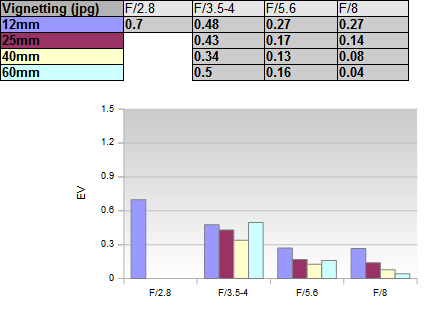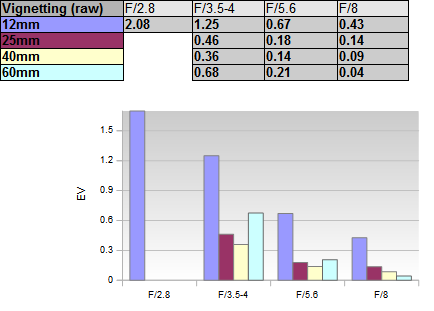|
Leica DG Vario-Elmarit 12-60mm f/2.8-4 ASPH Power OIS (Panasonic) - Review / Lens Test - Analysis |
|
Lens Reviews -
(Micro-)Four-Thirds
|
|
Page 2 of 3

Distortion
The Micro-Four-Third system uses an automatic distortion-correction thus from a user perspective, there is little to worry about. The system doesn't go for zero distortions but usually it's good enough for sure. Regarding the Leica lens images show a moderate barrel distortion (1.6%) at 12mm and there's barely something to report about beyond.
While most RAW converters as well as MFT cameras (JPEGs) don't give you a choice, a few still do (e.g Capture One) thus it is possible to verify the original characteristic of the lens. With disabled auto-correction, the Leica lens shows a massive barrel distortion of 6.1% at 12mm. However, there's barely any distortion in the middle range. At the far end you may notice a slight pincushion distortion in critical scenes.
Vignetting
Auto-correction is also applied to the vignetting characteristic. In this case, the system shows a relatively low degree (0.7 EV/f-stops) of light falloff at 12mm @ f/2.8 but there's, again, barely any noticeable vignetting (0.5 EV or less) at other settings.
 When looking behind the scenes again, the RAW vignetting is substantially different at 12mm only. At f/2.8 the light falloff is massive here and still obvious at f/4. At f/5.6 you may spot traces in certain scenes. However, the vignetting is mostly negligible in the 25-60mm range regardless of the aperture.
When looking behind the scenes again, the RAW vignetting is substantially different at 12mm only. At f/2.8 the light falloff is massive here and still obvious at f/4. At f/5.6 you may spot traces in certain scenes. However, the vignetting is mostly negligible in the 25-60mm range regardless of the aperture.

MTF (resolution)
Due to diffraction Micro-Four-Thirds tends to have its sweet spot around the f/2.8 mark (depending on the lens, of course). If you have a look at the following chart you will observe that the center quality is actually highest at one of the large aperture settings.
The Leica lens is generally a very good performer but it's not flawless. At 12mm, the center quality is excellent at fully open aperture whereas the outer image field is "just" good. Stopping down to f/4 or f/5.6 doesn't really improve the technical quality anymore. However, due to a bit of field curvature it is advisable to close the aperture by at least one stop in infinity depth-of-field scenes. As usual for MFT, you should avoid f/11 or beyond due to more pronounced diffraction effects. Remember that f/8 is already equivalent to "f/16" on full format camera when it comes to depth-of-field so it's rarely necessary to go beyond anyway. The sweet spot of the lens is clearly in the middle range. At 18mm (not shown) and 25mm the borders are very sharp and the corners are at least good to very good. Zooming out the 40mm, the quality improves further with a tack sharp image across the image field at f/3.9 and f/5.6. There's a slight decrease in resolution again at 60mm but the quality remain high here.
The tested sample had a good centering quality.
Please note that the MTF results are not directly comparable across the different systems!
Below is a simplified summary of the formal findings. The chart shows line widths per picture height (LW/PH) which can be taken as a measure for sharpness.
If you want to know more about the MTF50 figures you may check out the corresponding Imatest Explanations

Chromatic Aberrations (CAs)
Lateral CAs (color shadows at harsh contrast transitions) are low with an average CA pixel width below 1px at the image borders.

Bokeh
Micro-Four-Thirds may not be the hot-spot for shallow depth-of-field applications yet there's still some potential if you can keep a fairly close focus distance - so let's have a look at some details.
Out-of-focus highlights show an onion-like substructure. It's not terrible but not good either. Most likely this relates to the extensive use of aspherical elements in the optical design. Stopping down emphasizes the effect somewhat.
 The rendition of blur in the critical focus transition zone is not optimal. The blur is not symmetrical resulting in fairly hard edges. The more important background is smoother than the image foreground. Of course, these imperfections become obvious in scenes with harsh contrasts only.
The rendition of blur in the critical focus transition zone is not optimal. The blur is not symmetrical resulting in fairly hard edges. The more important background is smoother than the image foreground. Of course, these imperfections become obvious in scenes with harsh contrasts only.

|